MCINTOSH BATTERY & OPTICAL CO, CHICAGO, SCIENTIFIC MICROSCOPE NO. 2 WithCASE 1891
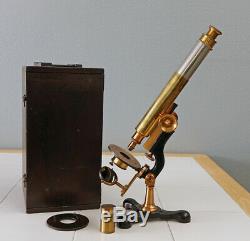
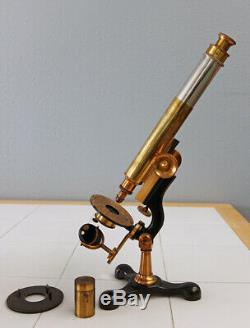
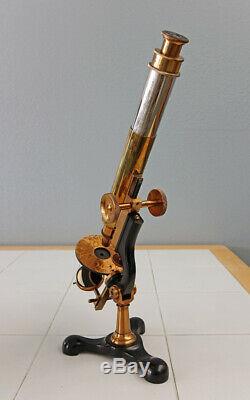
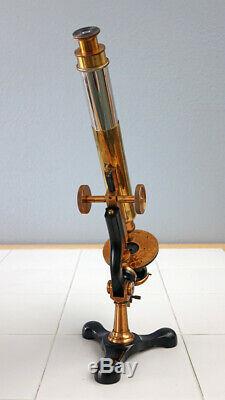
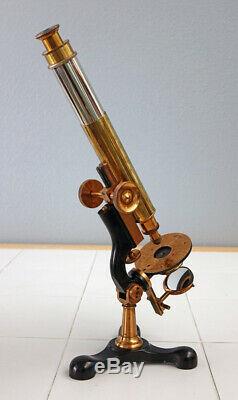
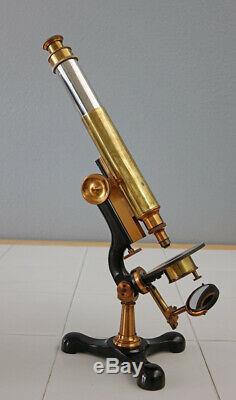


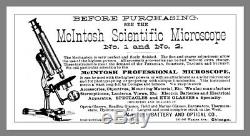
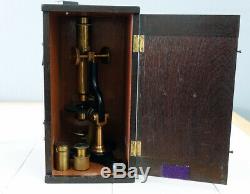
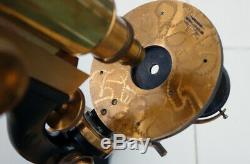


MCINTOSH BATTERY & OPTICAL CO. 2 WITH WOOD CASE, CIRCA 1891. Included with the microscope is a wood case that houses the instrument. McIntosh produced only a limited number of microscopes during his career, perhaps an estimated 600 to 700 units in number. According to Bracegirdle in his Notes On Modern Microscope Manufacturers , serial numbers from 213 to 472 were known when his book was published in 1996. Models found in known private collections and/or are available on the Internet generally seem to fall within this range of serial numbers.
However, another signed McIntosh Scientific Microscope No. It is also of interest that McIntosh did not sign and/or serialize all of his microscopes.
Also another signed Scientific Microscope No. 2 from circa 1885 in a private collection does not bear a typical serial number. NOTE: For more on the history of McIntoshs optical business, please see below. Based on information published in his 1895 Illustrated Catalogue of Stereopticons, Sciopticons, Dissolving View Apparatus, Microscopes, Solar Microscope and Stereopticon Combinations, etc , a total of five (5) microscope models were produced. His Professional Microscope model, which was also designed to be used as a part of a Solar Microscope or heliostat and also in conjunction with his Stereopticon a type of magic lantern.He was granted a US Patent (# 273,752) in March of 1883 for this model that included a feature that enabled it to be easily detached from its tripod base and incorporated into the solar microscope or stereopticon (magic lantern) setups. His New Clinical Microscope No. This was a dual pillar instrument.
1 had a manual pull-focus coarse focus mechanism, while the No. 2 had a rack and pinion coarse focus mechanism. This instrument featured a fine focus mechanism located under the limb above the rear of the stage. 1 differed from the No. 2 only by being finished entirely in lacquered brass. 2 included both black Japanned metal and lacquered brass parts. Featured here is Mcintoshs Scientific Microscope No. 2, which consists of a Japanned black tripod foot and limb, with the balance of the instrument finished in lacquered brass. This microscope is signed on the top front of the base brass stage plate, McIntosh Battery & Optical Co. Chicago (See close-up image that shows this).However, it does not bear a typical serial number. Based on its overall design , we can conservatively date this microscope to circa 1891.
Accompanying this listing is a catalogue cut of this same instrument along with a period advertisement with illustration for the Scientific Models Nos. 1 and 2 that appeared in the Monthly Journal, The Microscope Volume XI in 1891. The similarities to the featured instrument are readily apparent. This microscope is built upon a black Japanned metal tripod base. The top ends of the tripod feet are bulbous in nature, which is a distinctive mark of both of the McIntosh Scientific Microscope models. Rising from the base is a tapered lacquered brass pillar that terminates in a compass joint. The joint allows the microscope to be tilted to any angle from the vertical to horizontal. Attached to the compass joint is a nicely sculpted Jackson type limb of black Japanned metal. The leading edge of the lower limb is in the form of a disc at the center of which is an L-shaped bracket to which the lower brass stage is mechanically attached with two (2) screws. This arrangement allows for a space between the limb and the rear of the stage support in order to accommodate a swinging substage mirror assembly, which is described in more detail below. This instrument is equipped with a unique dual part stage one plate atop another with one fixed and one removable.On the bottom is a lacquered brass circular stage plate that is mechanically attached to the limb as noted above. This base plate features some fancy scroll work on its top surface, has the makers mark and has a 27mm diameter central aperture.
Fitting over this base plate is a removable 90mm diameter black metal circular stage plate with a wider 34mm diameter central aperture. A pair of slide clips is found atop this upper stage plate.
Under the lower brass stage plate is a brass sleeve, which in this case holds a brass cylinder that houses a disc of apertures. The movement of the disc of apertures is controlled by a brass knob that extends below the cylinder in easy reach of the observer at the microscope. Filling the space between the leading edge of the lower segment of the limb and the rear of the stage support bracket is a rotating mirror support bar. The pivot point for this mirror bar is the center of the leading edge of the lower limb at the compass joint so it can rotate around the axis of the stage both below (to provide oblique illumination) and even above the stage to provide incident light to illuminate opaque objects atop the stage (Please see the accompanying composite image that shows the versatility of this arrangement).This appears to be McIntoshs version of the swinging substage mirror assembly that was first invented and Patented by Joseph Zentmayer in the year 1876. The sides of the mirror bar form a male dovetail supporting a smaller female dovetail piece that fits into the bar and that slides along the bar and supports a yoke-mounted 40mm diameter plano-concave mirror. The mirror is mounted in brass.
It can be moved either closer to or away from the stage along the mirror bar. A pair of brass handles on either side of the mirror support facilitate is movement along the bar. Coarse focus is by rack and pinion controlled by a pair of oversized brass milled heads. The rackwork on this instrument is horizontal rather than angled (see image).
Fine focus is by micrometer screw that is found on the underside of the limb above the rear of the stage. Note: This is another distinctive feature of the McIntosh Scientific Microscope model. This location for the fine focus mechanism is quite convenient for the user of the instrument. The female dovetail that holds the coarse focus rackwork associated with the body tube is free to move along the front face of the limb and is spring loaded within the limb itself. Thus, when the micrometer screw is rotated the dovetail with the body tube moves slightly up or down providing a rather precise form of fine focus.
The lacquered brass body tube of this microscope includes a long nickel-plated drawtube with a brass ocular holder at the top. At the top of the drawtube in the ocular holder is a top-hat style ocular marked 1 ½-inch. At the base of the body tube is a single Ernst Gundlach Optical Company dual part ¼ and 1 objective.
The lower element of this objective can be removed (unscrewed) to allow for low power observations without removing the objective from the microscope. Included with the objective is a brass canister that is used to house the objective when not in use on the microscope. NOTE: McIntosh did not manufacture his own objective lenses. Thus, he customarily supplied objectives with his microscope made by other contemporary opticians including W. When this instrument is set up for observations with the drawtube fully extended, it stands about 18 inches tall making for a relatively large and impressive antique brass microscope.
When the draw tube is fully nested into the body tube and the body tube is racked down to its lowest position with the objective and eyepiece removed for storage inside the wood case, the instrument stands about 13 inches tall in its collapsed state. The microscope weighs about 7 pounds. Included with this microscope is a wood case that houses this instrument. This is not the original wood case for this microscope, but it comes from the same time frame as the microscope itself. This case is equipped with a leather handle at the top along with a pair of brass hooks and pins that hold the case door firmly shut when the microscope is stored inside.
The exterior dimensions of the wood case are 13.5 inches tall, 7 inches wide, and 8.75 inches deep. The microscope in its case weighs about 12 pounds. NOTE: The accompanying images that were captured under ambient light conditions are a part of this statement of condition. Please take the time to view each of the images so you can confirm the condition of the instrument and so you will know in advance what you will be getting should you prove to be the proud new owner of this very fine and quite rare American made microscope.In summary, this McIntosh Scientific Microscope No. 2 is in relatively good to excellent cosmetic, optical and mechanical condition considering its age.
More details are noted below. Cosmetically, this microscope is in relatively good condition. The black Japanned parts including the foot and limb are in good condition with no major surface defects in the finish. The lacquered brass parts are also in relatively good condition, but with just a modicum of spotty tarnish present mainly on the brass ocular holder atop the drawtube, on the compass joint and on the mirror holder. The front face of the body tube has some very subtle vertical dark streaking and surficial tarnish present.Overall, I would estimate original lacquer retention in the range of 92 to 95%. The lacquered brass parts have a very nice honey gold patina that is quite attractive. The only cosmetic treatment we have given this instrument was to clean it of dust and grime with Windex followed by a coating of Renaissance Wax from the GEMMARY to protect it. NOTE: We make it a firm practice not to deep clean and polish antique brass microscopes. Relative to the optics, the top hat eyepiece is in excellent condition with no internal defects present.
The 1-inch lower element of the Gundlach objective is cracked in two locations at its very edge. The lower removable ¼-inch element is in good condition with no defects evident.
Despite the presence of edge cracks in one element of the objective, it still provides acceptable views at the eyepiece. It appears that the defect in the 1-inch element is far enough to the edge so as not to impact images viewed through this instrument.
Both sides of the plano concave mirror are in excellent condition. The mechanics associated with this instrument are in very good condition. Both the coarse and fine focus mechanisms work perfectly and smoothly. The swinging substage mirror system rotates smoothly as designed.One of the two slide clips atop the upper stage plate is broken in half. The lower brass stage plate is in excellent condition. The wood case that houses this microscope is in very good serviceable condition. As noted above, it is not the original wood case for this microscope, but nicely houses the instrument for safe storage when it is not in use.
All in all, this instrument is a nicely preserved example of a McIntosh Battery and Optical Company Scientific Microscope No. 2 and is certain to command a prominent place in any antique microscope collection especially since so few of his microscopes have survived the ravishes to time and circumstances. McIntosh was a physician-surgeon, inventor, electrician and entrepreneur.
He received his medical degree from Caledonia Medical College in Caledonia, Vermont in 1863. After graduation, he served as a surgeon in the Union Army during the Civil War. After the war, he practiced medicine in Sheboygan, Wisconsin before moving to Chicago, IL in 1872. In addition to his medical practice, McIntosh was particularly fascinated with electricity and produced several electrical devices that we now call quack medical devices designed to improve health or to cure disease. He also was fascinated with magic lanterns for use in public displays.
In addition, he designed, produced and offered several microscope models for sale a total of five different models. Beginning in the year 1872, he formed several different companies to offer his inventions and wears to the public. In 1882 he formed the McIntosh Galvanic and Faradic Battery Company. In 1889, he changed the name of the company to McIntosh Battery and Optical Company apparently to more closely reflect the fact that he offered both electrical and optical instruments for sale.His place of business was listed at 521 to 531 Wabash Avenue in Chicago. In 1883, McIntosh exhibited 11 microscopes at the annual meeting of the American Society of Microscopists.
In 1890, he exhibited 5 microscopes and other equipment at the American Society of Microscopists meeting in Detroit, MI. McIntosh died in Florida in 1892. Olmsted Scientific Company, which in turn was bought out by the Chicago Laboratory Supply & Scale Company in 1898. It is highly unlikely that the microscope part of the business that was started by McIntosh survived into the 20th Century. THE MONTANA LOGGER is very pleased to offer this McIntosh Scientific Microscope No. We will also entertain reasonable offers for this very rare instrument. FREE scheduling, supersized images and templates. Make your listings stand out with FREE Vendio custom templates! Over 100,000,000 served. Get FREE counters from Vendio today! The item "MCINTOSH BATTERY & OPTICAL CO, CHICAGO, SCIENTIFIC MICROSCOPE NO. 2 WithCASE 1891" is in sale since Monday, March 25, 2019. This item is in the category "Collectibles\Science & Medicine (1930-Now)\Scientific Instruments\Microscopes, Lab Equipment".The seller is "mtloggera" and is located in Hamilton, Montana. This item can be shipped worldwide.
- Antique Brass Microscope: Scientific Microscope No. 2
- Year of Manufacture: circa 1891
- Country of Manufacture: Chicago, IL, USA
- Manufacturer: McIntosh Batter & Optical Company
- Product Type: Microscopes, Lab Equipment
- Country/Region of Manufacture: United States

